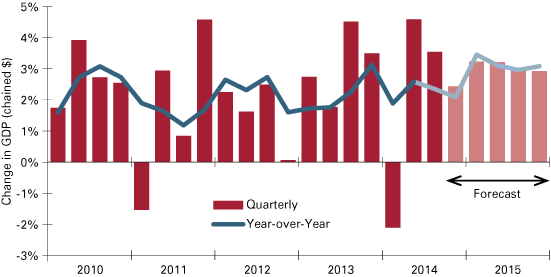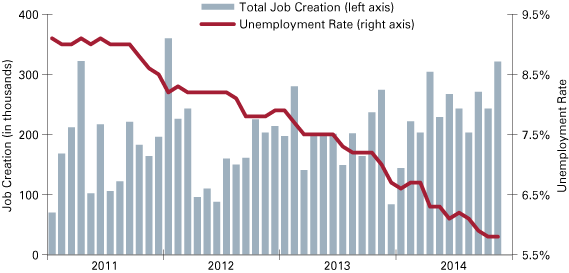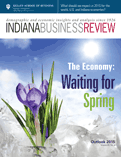U.S. Outlook for 2015
Professor Emeritus, Department of Economics, Indiana University Bloomington
The United States economy has given clear signs that it is finally breaking out of the rut that it had been stuck in during the first four years of the “recovery.” The improvements in the past year are generally in-line with our predictions made a year ago. Looking ahead, we expect the coming year to produce a continuation of these positive trends. But this favorable outcome is far from a sure bet. The level of uncertainty in the current environment is high. As we took the Business Outlook tour on the road, our catch phrase was “apprehensively optimistic.”
The first four years of the recovery (mid-2009 through mid-2013) were remarkably uniform on average. There was the normal quarter-to-quarter volatility, and also some temporary impact from the stimulus program, but even these were muted. The pattern of this period had output growth that averaged just 2 percent, about a full percent below the pre-recession norm and also below the long-run potential of the economy.
This subpar situation was driven by consumption growth in-line with the overall economy, business investment that was sluggish by historical norms, and a housing sector that was recovering but from a very low base. Growth was held back by decreased government spending as states and local governments adjusted to a significant budget crunch due to both a decrease in revenue and to over-expansion during the pre-recession boom.
In the labor market, employment increases averaged about 175,000 per month and the unemployment rate declined at just short of one tick per month. Unfortunately, a significant part of the fall in unemployment was due to very sluggish growth in the number of individuals participating in the labor market, as the labor force participation rate fell to its lowest level since the 1970s. The employment gains, which were unimpressive compared to previous recoveries, were also characterized by a large number of part-time positions. Overall, this recovery was indicative of an economy in a rut, which is better than being in the ditch, but still disappointing.
Now, things are looking up. As seen in Figure 1, GDP (in chained dollars) over the past five quarters has been growing at an annual rate of 2.8 percent, with four of those quarters well above 3 percent. (Admittedly, the outlier [2014 Q1] was pretty bad at -2.1 percent, but that was partly due to terrible weather.) Components have mostly picked up, as well. Consumption continues to parallel overall growth, with auto sales particularly strong. Business investment has grown at a 6.5 percent rate, and the shrinkage in the government sector moderated and then reversed in 2014’s second quarter. The one disappointment has been housing where the earlier growth has disappeared.
Figure 1: U.S. Real Output Rate of Change

Source: U.S. Bureau of Economic Analysis
In the labor market, the improvement is even more evident (see Figure 2). Over the past year, employment has risen by an average of 228,000 per month. That has increased further, to 258,000 per month, during the past six months. Unemployment has continued its steady decline, falling from above 7 percent at this time a year ago to 5.8 percent this November.
Figure 2: U.S. Monthly Job Creation and Unemployment Rate, January 2011 to November 2014

Source: U.S. Bureau of Labor Statistics
The improved output performance was not unexpected. If the final segment of 2014 matches our expectation, the full year will be quite close to our year ago forecast of about 2.5 percent growth. The labor market, however, has exceeded our expectation. The economy is on track to add about 2.7 million jobs in 2014, significantly above our forecast. Unemployment has similarly fallen more than we anticipated.
2015 Outlook
Looking to the year ahead, we think the economy will sustain its recent progress. The gains of the past year should be maintained, with further improvement in some areas. To be more specific:
-
We expect output growth in 2015 to average close to 3 percent. This will be somewhat better than the past year, with progress coming across the board, but especially from a stronger housing sector and from government shifting from contraction to (weak) expansion.
-
The labor market will maintain its recent strength. Employment will show monthly increases consistently above 220,000 during 2015, with the possibility of some months at or above 300,000. That would imply an unemployment rate below 5.5 percent by the end of the year.
-
We expect inflation to remain well contained in 2015. Lower energy prices will be a factor here.
-
After its recent lull, the housing sector should be stronger in 2015. However, a return to the level reached during the pre-recession boom is not in the cards.
-
As we anticipated, the Federal Reserve has phased out its asset purchase program (aka quantitative easing). For almost six years, the Fed has held short-term interest rates at virtually zero, and it says it will maintain this stance “for a considerable time after the asset purchase program ends.” We think this means that rates will start to edge higher in mid-2015. By the end of the year, we think short-term rates will be approaching 1 percent.
-
We think the election outcome raises a possibility of progress on taxes, particularly reform of the corporate income tax. If this materializes it would be very positive for the economic outlook.
There is, unfortunately, a long list of things that could upset our expectations. To begin with, unlike in the United States, the economic situation in most of the rest of the world has deteriorated during the past year. Europe may be sinking into its third recession in the past decade. The security situation in Eastern Europe and in the Middle East is beyond depressing, and it is negative for economies in the regions and beyond. The Chinese economy is clearly decelerating and this too could have far-reaching impact.
Another wild card: energy prices, which are a good news/bad news story. The decline to date is quite positive for household budgets, implying some potential upside to our estimate for consumption. On the other hand, declines in crude prices much below $80 per barrel would begin to adversely affect domestic investment in the industry, which has been a bright spot in the recovery.
Finally, if the Fed begins to raise interest rates as we expect, there will be the potential for significant instability in the financial sector.
Nevertheless, we are optimistic about the outlook for 2015. There has been definite progress in the economy over the past year, and we expect that to continue next year. If we are right, 2015 will be the best year of the recovery so far.




